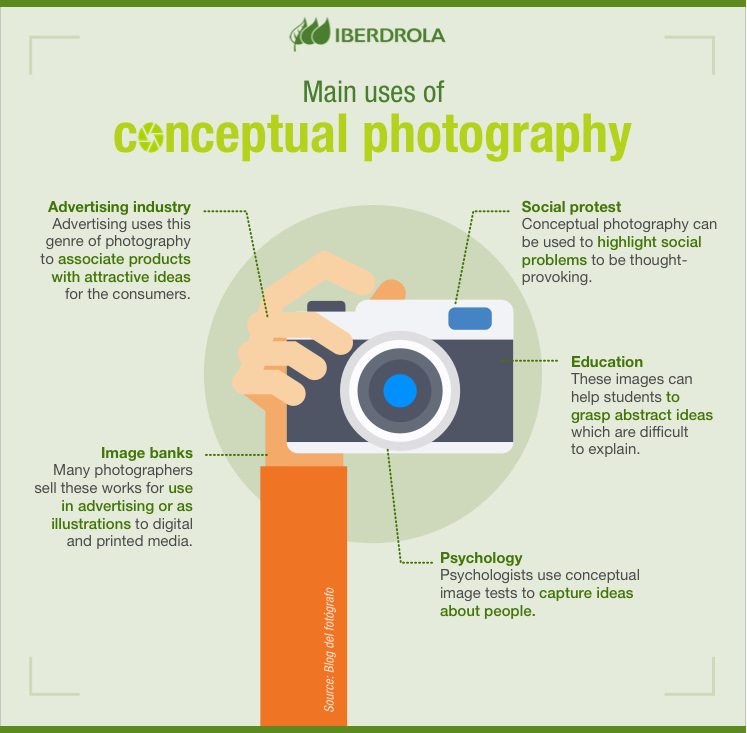What is conceptual photography?
Conceptual photography or the art of representing the abstract
Conceptual photography speaks through images. Each image captures a powerful message capable of transmitting highly abstract concepts to our thoughts. This discipline of art has been increasing in importance with the years and is now one of the categories in the renowned Sony World Photography Awards.

Conceptual art emerged at the end of the sixties, bringing a new meaning to photography that transcends its use for portraiture, landscapes and snapshots. Rather than two-dimensional, soundless images, conceptual photographs are full of meaning, using creativity to evoke abstract ideas and emotions like love, nostalgia, loneliness and the passing of time to arouse a reaction from the viewer.
One of the main features of conceptual photography is the fact that artists design the scenes and prepare them meticulously to accentuate their messages. This sometimes involves including impossible or exaggerated components or manipulating the piece with digital editing for high impact.
The image that opens this article — untitled and of anonymous authorship — shows the barrel of a gun loaded with cigarettes instead of bullets. The underlying message is instantly understandable and reflects perfectly everything commented about conceptual photography.

Step-by-step guide to artistic conceptual photography
This complex genre of photography is one of the most difficult. Here are some tips before you start shooting:
Define your concept
The first step is to design the scene and decide what it is you want to transmit.
Search for inspiration
Good ideas rarely fall from the sky. Conceptual photography requires method, discipline and work routines such as continuous reflection, observation and exploration.
Write your ideas down
When something pops into your mind, jot it down immediately in a notebook or in your mobile so that you don't forget it.
Use symbols
Many symbols are universal and can be used to express concepts like time (watch/clock), infinity (straight road disappearing into the horizon), etc.
Keep your message simple
Make the idea as easy to understand as possible. Images are open to different interpretations, but the message should be clear.
Meticulous production
This is the phase when you work on technical aspects such as the type of lens, frame, lighting, location, composition, objects and models, etc.
Impeccable postproduction
This includes photo editing and post-production. It's one of the most crucial stages and can take week or months.
Artistic movements of conceptual photography
There are two main ways of conceiving this artistic discipline, depending on the type of message you want to transmit:
- Consists of rather simple images and compositions, without distractions, sending a clear, universal message. The audience should immediately capture the artist's intention, with no possibility of misinterpretation.
- Addresses complex ideas with photographs that contain more elements and symbolism. In this case, the message is more diffuse, and the meaning of the image is determined by the reader's interpretation. This branch of conceptual photography is more risky, since the audience may misunderstand the intention or it may go unnoticed.
Conceptual artists to follow
These are some of the world's biggest names in this genre of photography:
-
Chema Madoz: This Spanish artist is considered an international leader in conceptual photography. He has been awarded the National Photography Prize and the Higashikawa Award, among others, and has shown in galleries and museums the world over.
-
Jordi Larroch: is a spanish photographer and poet whose work combines slightly altered everyday objects to give them a new meaning. Larroch's photographs are divided into two series (Black and White).
-
Amy Stein: Amy Stein is an American photographer. Some of her photo series include Stranded and Domesticated. Stein's work explores our relationship with the wild and the impact of our impulses on human and animal behaviour.
-
David Levinthal: american photographer famed for using dolls and toys in dramatically lit scenes that give them a human appearance. Most of his work refers to American pop culture and colour TV.
-
Heidi Lender: this American photographer started out writing about her experiences in photo sessions for fashion magazines. Behind the camera, Lender explores the condition of humanity. Self-portraiture is a frequent theme in her work.




